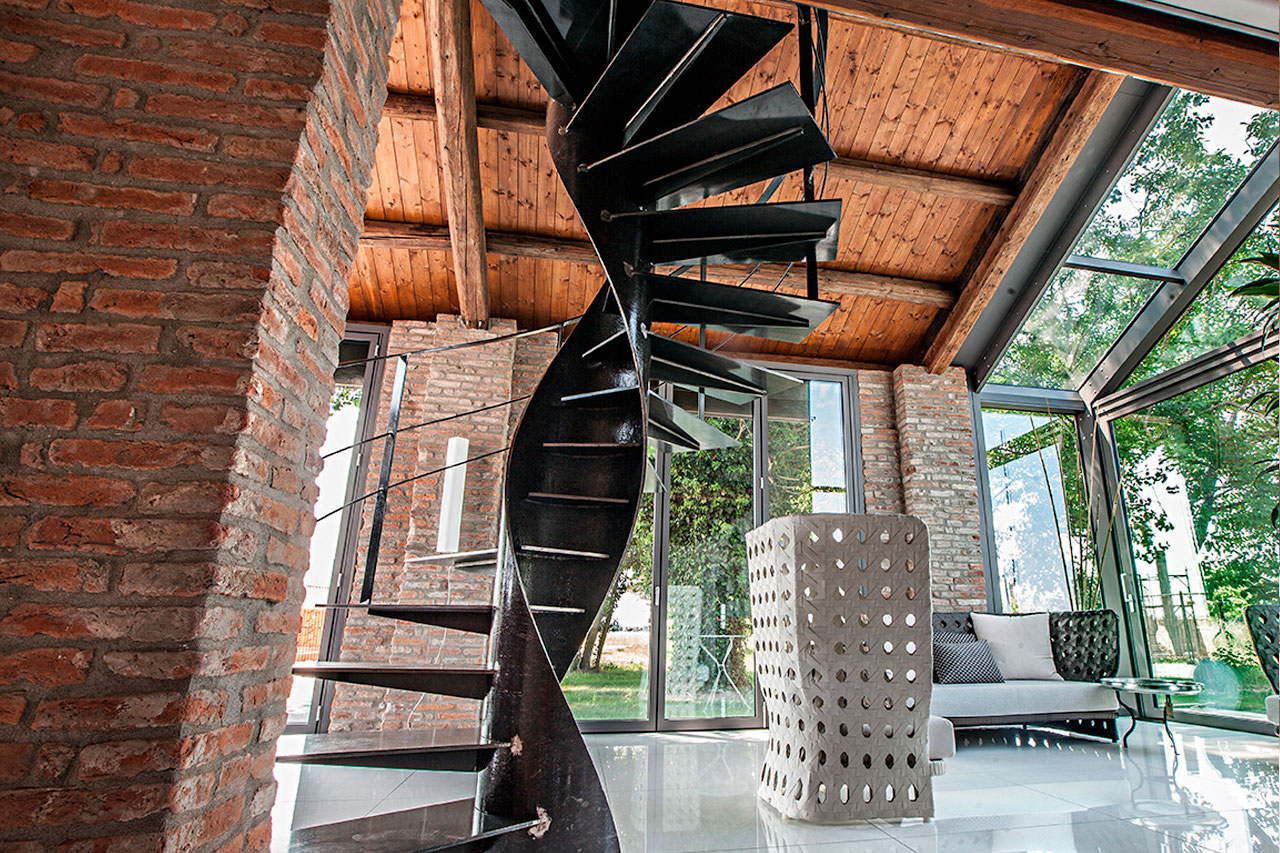
Spiral staircase: everything you should know and even more
22 February 2023
Scaletta dei contenuti
The spiral staircase is a type of installation, vertical connection between different levels, subcategory of the world of stairs, distinguishable by its spiral lines, ideal for both indoor and outdoor.
It combines characteristics and variants that are difficult to list in two words. A spiral stair case and the modern version, that is the helical evolution, is in general the favorite one when the ratio is the optimization of the space; but its peculiarities go far beyond that.
It is enough to look for a moment at its history, to understand how the spiral staircase had its own: as only possible link to very narrow towers or minarets (stone or wooden) in general became known during the Middle Ages – although used millennia earlier in all probability – because it was able to limit the throng of a crowd of enemies who could travel it simultaneously.
So spiral staircases have been exploited for its space-saving qualities since its inception, then later it was perhaps more appreciated for their sinuous aesthetics; there are examples around the world that have become famous.
Let’s see together the characteristics and peculiarities of this type of realization, which within the world of stairs, enjoys its own space.
Modern spiral staircase: how many types
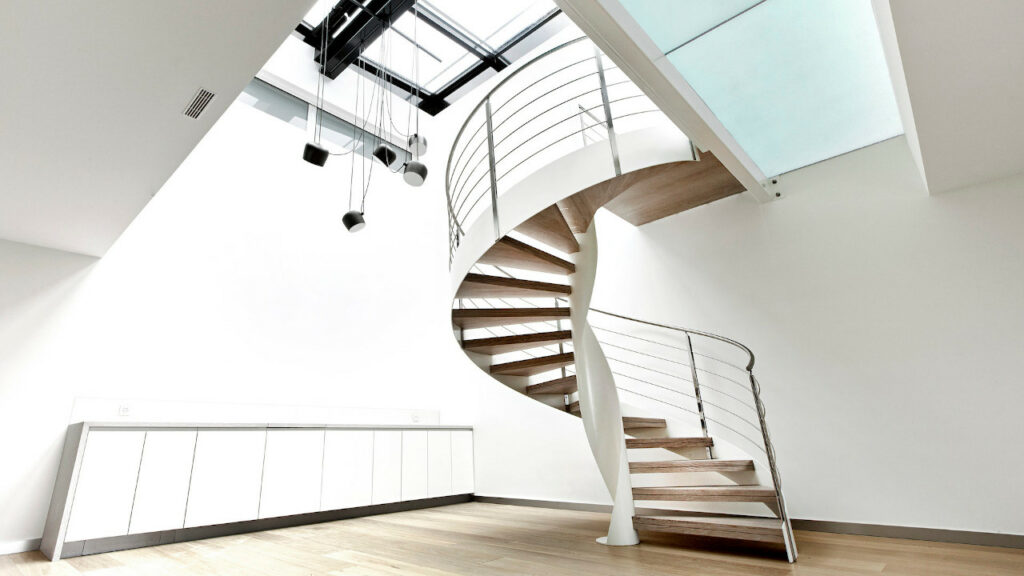
Let’s start from the basics: what is a spiral staircase and how many types exist? Soon said! First of all, it is a connecting element that develops completely vertically around a central pole or column from which the steps branch off and consequently follow any railings or balustrades.
In addition to the central column, specific to the spiral staircases – for outdoor or internal – are the spacers between one step and the other, replaced in some staircases by veils under the steps or by external lateral side band to support them, while the base of the staircase consists of a connecting plate to the floor from which the structure stands.
The characteristic visible even to an inexperienced eye is the sinuosity of the spiral lines in the first place, and secondly the difference compared to the other stairs in the development and occupation of space: any other type of staircase also requires horizontal space, while a spiral staircase plan , circular but also the spiral staircase square, follows the verticality of the pylon around which it winds.
Among modern spiral staircase examples, I can propose a technical subdivision based on the geometry of the plan; we can have in fact:
- Circular plan
- Square plan
- Elliptical plan
In general, their distinction is based precisely on the shape of the staircase in plan; in practice, to give an example, we can see that a square-plan staircase will make the most of the existing angular spaces and the tread will be wider and easier to walk.
Obviously the sinuous lines typical of the canonical spiral staircase will suffer, and the overall design will appear more rigid, but the optimization of the spaces may well be worth some sacrifice.
In any case, a spiral staircase square is perfect for angular positions making full use of every inch lost by the circular lines, but its particular shape makes it pleasant and functional anywhere in the room that suits your project.
So, in summary, a modern staircase can have different structural shapes while maintaining the two main features, namely the verticality and the spiral structure that always has a very strong aesthetic impact.
If the space saving spiral staircase – so called for the obvious optimization of the spaces that characterizes it – is the circular one, there is a modern evolution called helical staircase. Perhaps a layman might not notice the differences at first glance, but there are also significant differences, both aesthetically and functionally.
Let’s see them together.
Spiral helical staircase: the evolution
Whether we are talking about an internal staircase as a loft spiral staircase, or an external one, the one we use may not be at all: in fact, its modern and beloved evolution in the sector is called helical staircase and could be confused.
The visual effect at first glance can be the same as a classic staircase but there are variations: it always develops circularly upwards but not exactly around a central column.
In fact, a spiral helical staircase consists of two helical helices, internal and external, around the so-called eye. Suitable for larger spaces than the classical spiral staircase, this type is wider, with the same diameter, in the tread and in the passage; otherwise gives its best aesthetically speaking in larger sizes.
Obviously like all other types of staircase can be designed in any combination of materials and finishes: metal, wooden, concrete, cast iron, glass spiral staircase, natural stone and so on…
it pursues a more successful aesthetic rather than space saving. Consequently, it is the perfect modern solution only if space is not the very first problem to deal with, compared to classic spiral stair.
Spiral-helical Vortika by Officine Sandrini
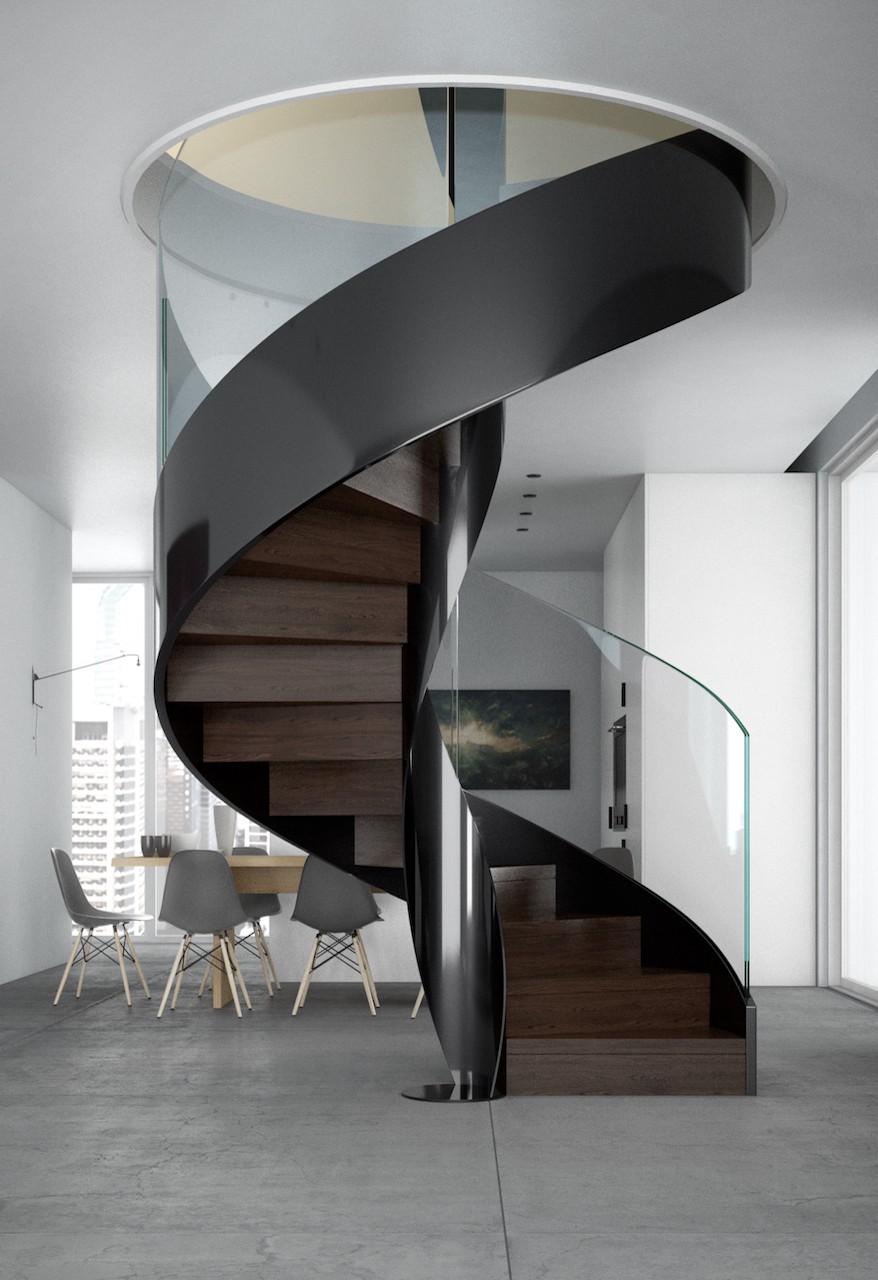
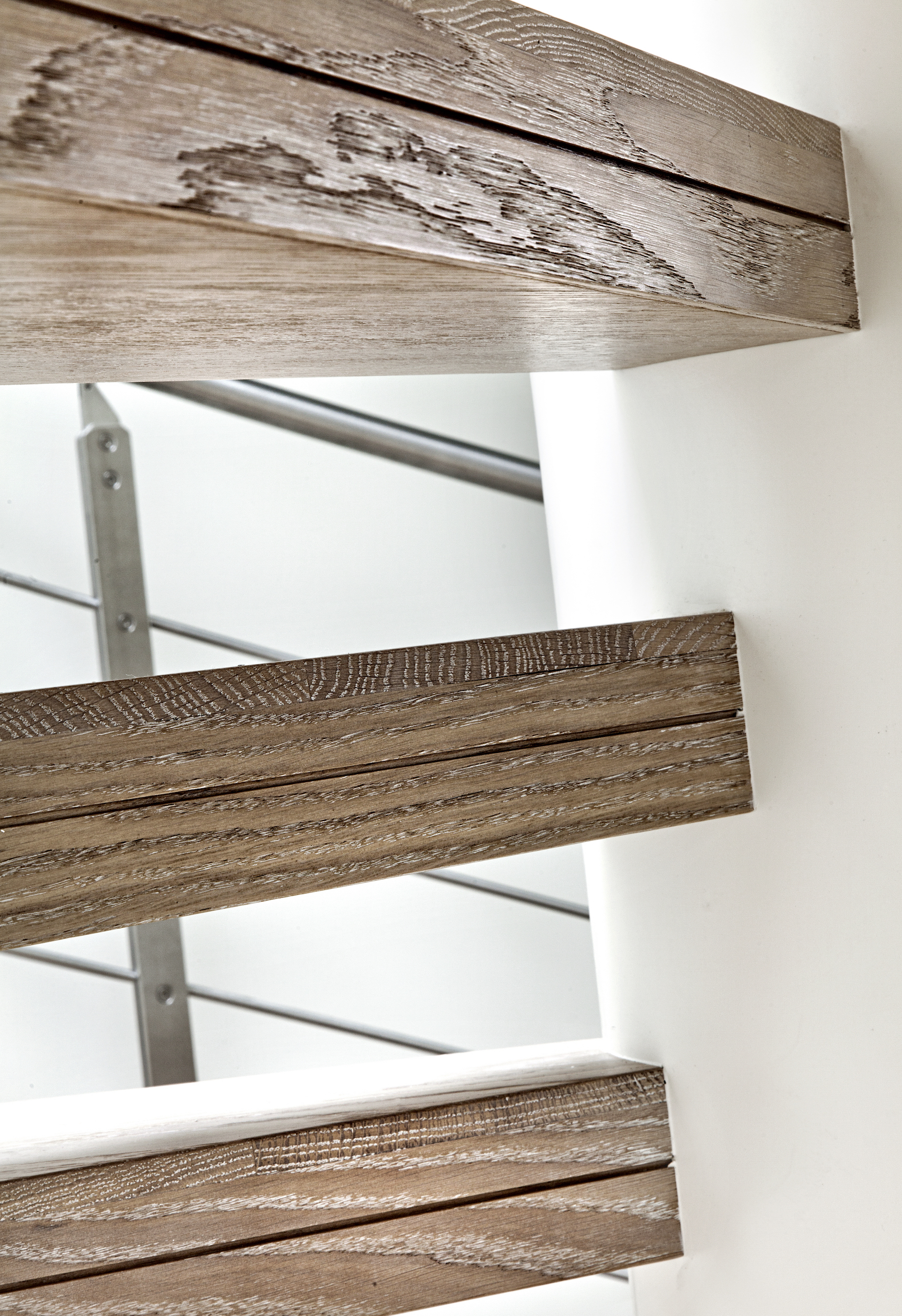

The staircase Vortika is a clear example of how a spiral staircase can be completely customized and become the staircase perfectly suited to an interior.
In each of its variants and combinations of materials, Vortika adapts to the structural and dimensional needs, as well as the stylistic needs of the context that will host it.
With the dynamism that distinguishes the staircase, it integrates completely into the context while maintaining a strong personality. Vortika by Officine Sandrini becomes a striking piece of furniture and design, whatever the level of customization with which it was designed.
Do you want to know more about spiral staircases, how to include them in your project or do you have any curiosities to submit to our experts? Fill out the form, and request a free telephone consultation!
Outdoor spiral staircase, as well as for interior design
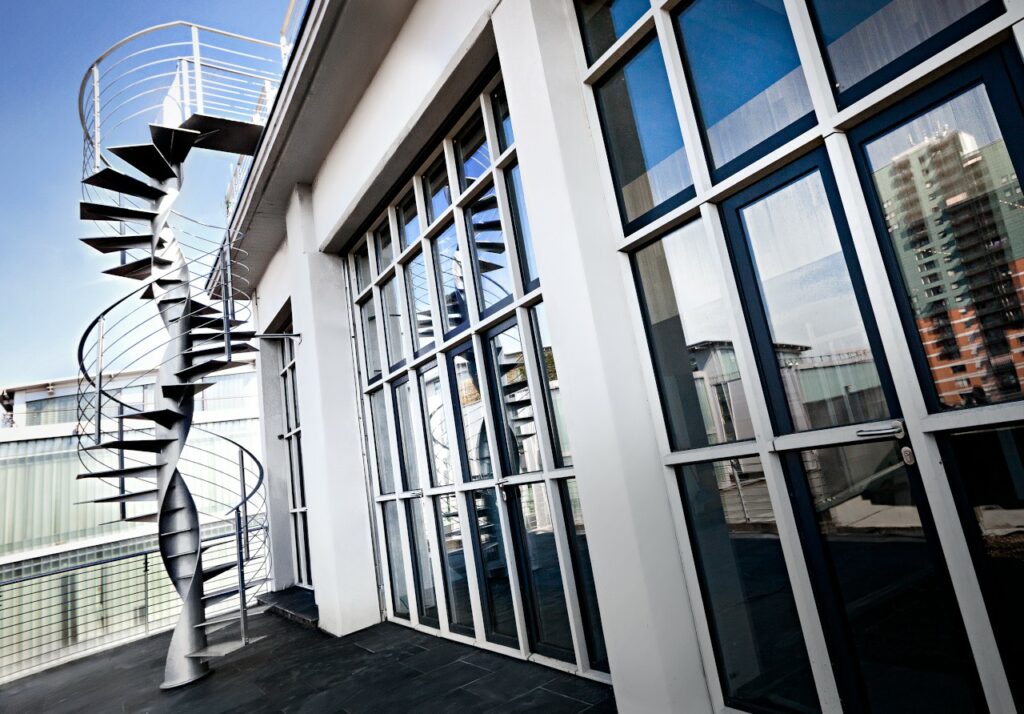
If it is now acclaimed that a well-designed staircase brings to the interior much more than a mere functional solution of connection between different floors and different environments, enriching with its design the overall style of the remaining furniture, this is especially true for spiral staircases.
In this case, talking about a small spiral staircase or even a larger helical staircase for indoor use, a staircase loft conversion or a compact spiral staircase in other rooms of the house, we know how these installations can change the aesthetic fate of the environments that host them.
This is also true for the outdoors: the outdoor spiral staircase, with its ease of use and visual impact, is also perfect for external places.
An external spiral staircase can easily solve problems of connections between different levels even close to a facade, in the same way that indoor staircases solve functional problems but also pull in a sense the rows of style of all the surrounding furniture.
Outdoor spiral staircases make it easier and more comfortable to walk between garages and upper floors, terraces, gardens or simply create alternative access.
The possibilities of use are various, and a small spiral staircase or a space saving staircase is very useful and decorative in indoor and outdoor contexts, adding value to your property and adapting to any style.
Thousand materials possible for a spiral staircase, internal stairs and outdoor spiral staircase
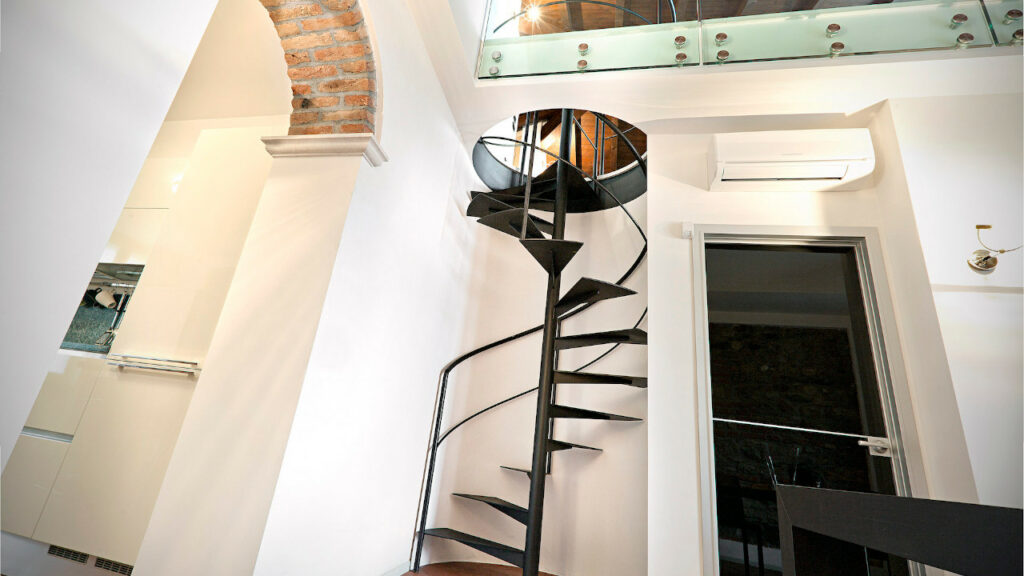
How many materials are available for stairs, and more specifically for spiral staircases (above all for a modern spiral staircase)? As many as you can imagine!
In fact, thanks to technological innovation it is possible to take advantage – or speed up production processes compared to the past – of many different materials, and combine them together in unexpected ways.
Internal spiral staircases
As for internal spiral staircases, the choice is really wide, although always to be made with care: in fact it is not only a matter of style and aesthetics, but also practical use, thinking for example about the noise that can be produced along the staircase or if the tread material may prove to be too soft for a frequent passage…
In short, the assessments must not be superficial in any case with regard to the materials, since a well-designed staircase, above all, can have such a great specific weight in the enhancement of an environment. The possibilities and combinations are many for the interior, we can in fact have:
- metal – iron – both natural and with painted or even specially oxidized finish, always appreciated as adaptable in many contemporary and modern environments
- metal – wrought iron – more decorative and baroque aesthetic
- wood, loved in environments with a traditional or even classic mood, for a rustic style but also choices in contrast in a modern environment, appreciated for the warmth and variety of woods
- concrete that can be extremely simple but also highly scenic
- stone made, a valuable investment
- high tech plastic stairs of the latest technology
Steps can be, or even be covered with materials other than the structural ones of the installation: glass, wood of a thousand different species with different characteristics and colors, iron in various finishes, steel or solid surface materials of recent generation and many more.
External spiral staircase
With regard to the outdoor spiral staircase, some extra care is required compared to an indoor one, due to the presence of atmospheric agents that the staircase must face, unless it is covered.
In fact extreme temperatures, rain, frost, sun can affect over time the integrity of an external spiral staircase, not to mention the salt in the sea, if the project is not well studied to cope with this problem.
Also the external staircase does not end its task with the only primary function of connection but represents a real business card in harmony with the style of the interior; a frequent choice is the staircase in iron, steel, cast iron but also in traditional wood or natural stone.
In order for the outdoor staircase to remain always perfect, it must be galvanized if it is made of metal or in general water-repellent painting.
If we talk about a wooden spiral staircase made (which could be solid, laminated or of any more or less valuable essence), this must be chosen ad hoc high strength and/or treated, the same applies to natural stone (for example, marble variants with multiple veins are more vulnerable to water wear).
As for safety, in addition to the necessary protection of handrails and railings, for your external staircase you will have to design non-slip steps, ideal to preserve from accidents during the journey of the spiral staircase.
Etika spiral/helical staircase by Officine Sandrini

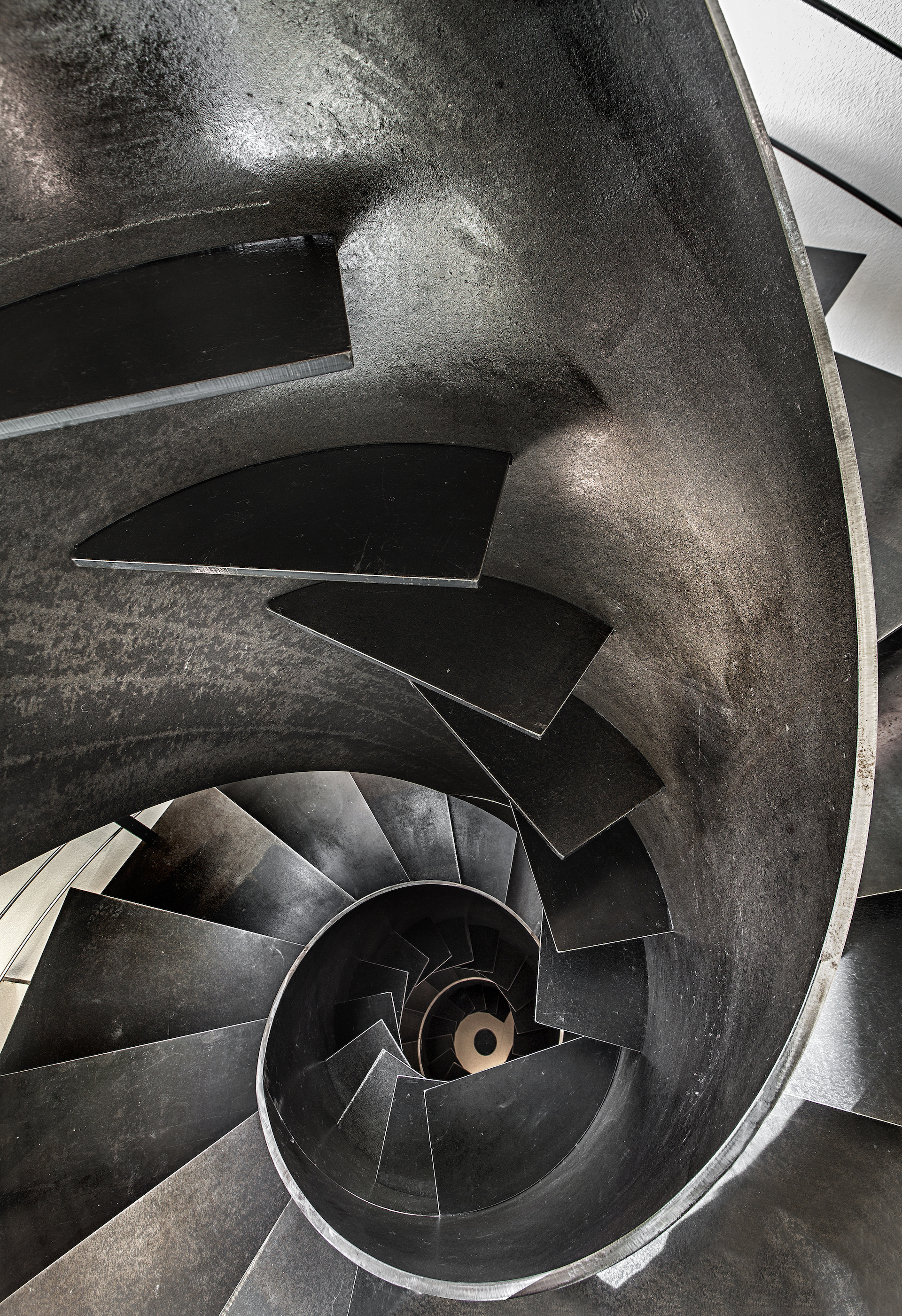
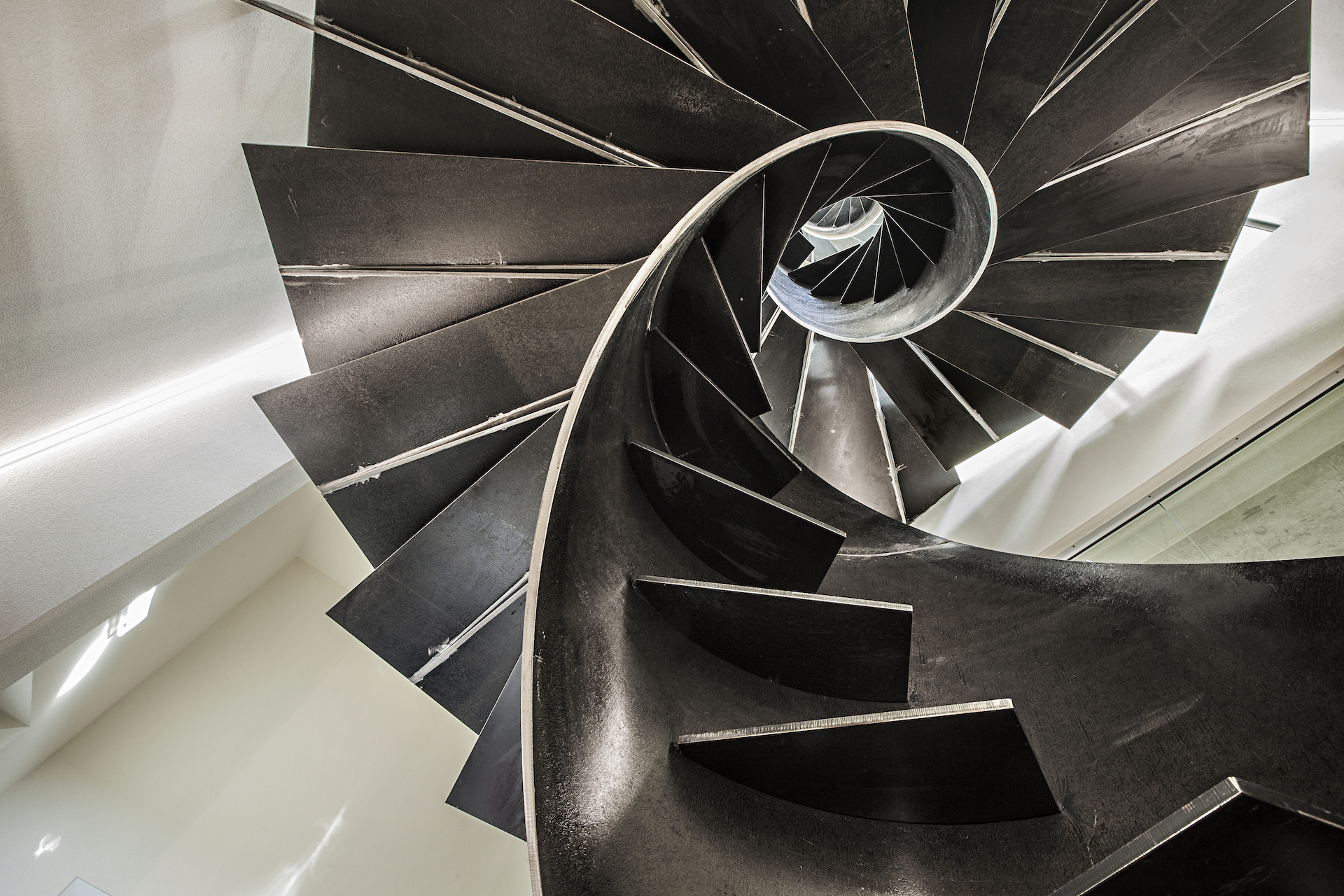
The Etika spiral staircase is the result of technical and artisanal processes of the highest level: it is not a simple metal staircase, but a real wonderful artifact of pure design.
The creative variants and the possible finishes for the metal are many, but one thing unites all the – unique – Etika: it is a staircase, for indoor and outdoor, which contains many elements that go far beyond the design ability, in fact, it is the result of a well-defined tradition of craftsmanship combined with innovation and search for a strong style and strong personality.
Do you want to know more about spiral staircase, how to include them in your project or do you have any curiosities to submit to our experts? Fill out the form, and request a free telephone consultation!
Project for a spiral or helical staircase: precautions and normative measures in Italy
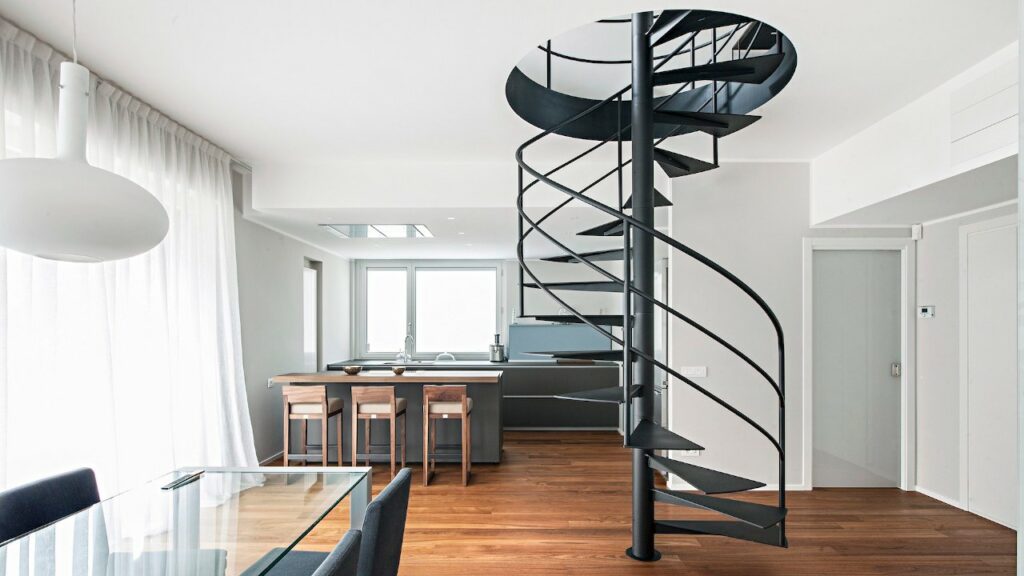
The structure of a spiral staircase but also of a helical staircase is convenient to use and relatively simple and fast installation. We have already mentioned how much weight is in choosing this type of installation, its minimum footprint capacity, compared to other types of stairs.
The design and its actual realization is not so simple, especially when tailored and not in series.
Clearly how small the diameter of your spiral staircase will be the more narrow and difficult the passage… There is even a so-called semi-spiral staircase on the market, a real space-saving spiral staircase, but with obvious contraindications.
In general, there is legislation that seeks above all the safety of the users, concerns spiral staircase dimensions, the size of the spiral staircases, steps, lifts and also what concerns the management of the railings and balustrades.
Spiral staircase dimensions and parameters to be respected in Italy
I have already told you about the variety of structures within the set of spiral staircases, with plans that may not be circular for example or even, between the helical stairs, may have straight sections alternating with curvilinear sections etc.
Spiral staircase is still the first choice if you do not have the appropriate horizontal space for other types of stairs, but also for the refined design that refers to. But there are basic rules to follow during the design.
UNI 10804 defines guidelines on minimums, development of ramps, risers, treads and many other details, dividing main private contexts from secondary private contexts (but there can always be exceptions or derogations).
The minimum diameter in the main private context, for spiral staircase circular or spiral staircase square plan, should be 160cm; instead in secondary private context for both types the minimum diameter could be identified at 120cm.
Talking about spiral staircases with a square plan, we can safely say that they are among the easiest to walk, since the steps that obviously take a different shape than those of a staircase with a circular plan, offer a larger area.
In an intermediate band of diameters, without minimum extremes or, on the contrary, colossal we could have a spiral staircase square 120×120, spiral staircase square 140×140, spiral staircase square 150×150 medium size but also a spiral staircase square 160×160.
In terms of height you can really vary a lot up to exceed 4 meters if necessary, in any case what matters is always the ratio between lift and tread and consequently the calculation of the number of steps that will be necessary to design.
Vitre spiral staircase by Officine Sandrini
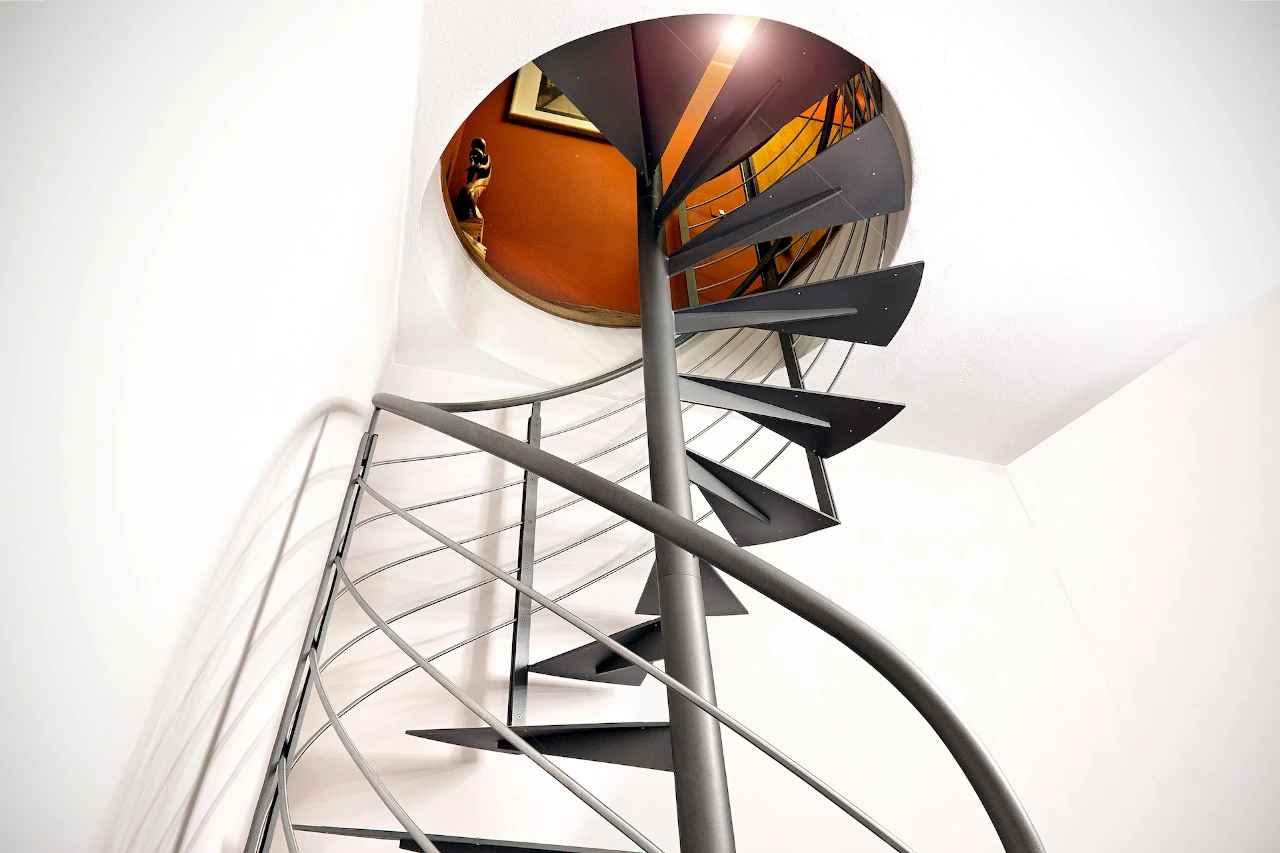
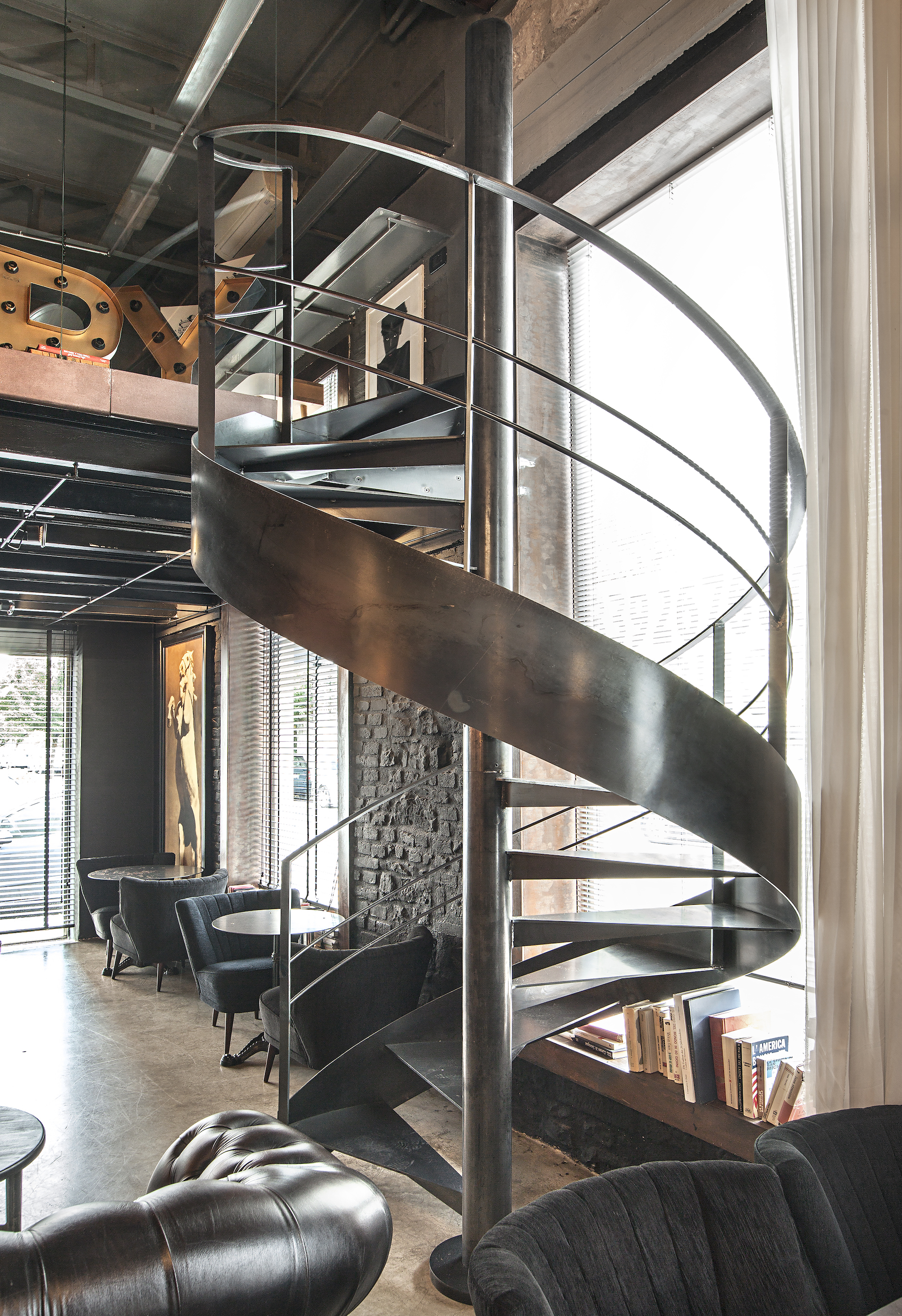
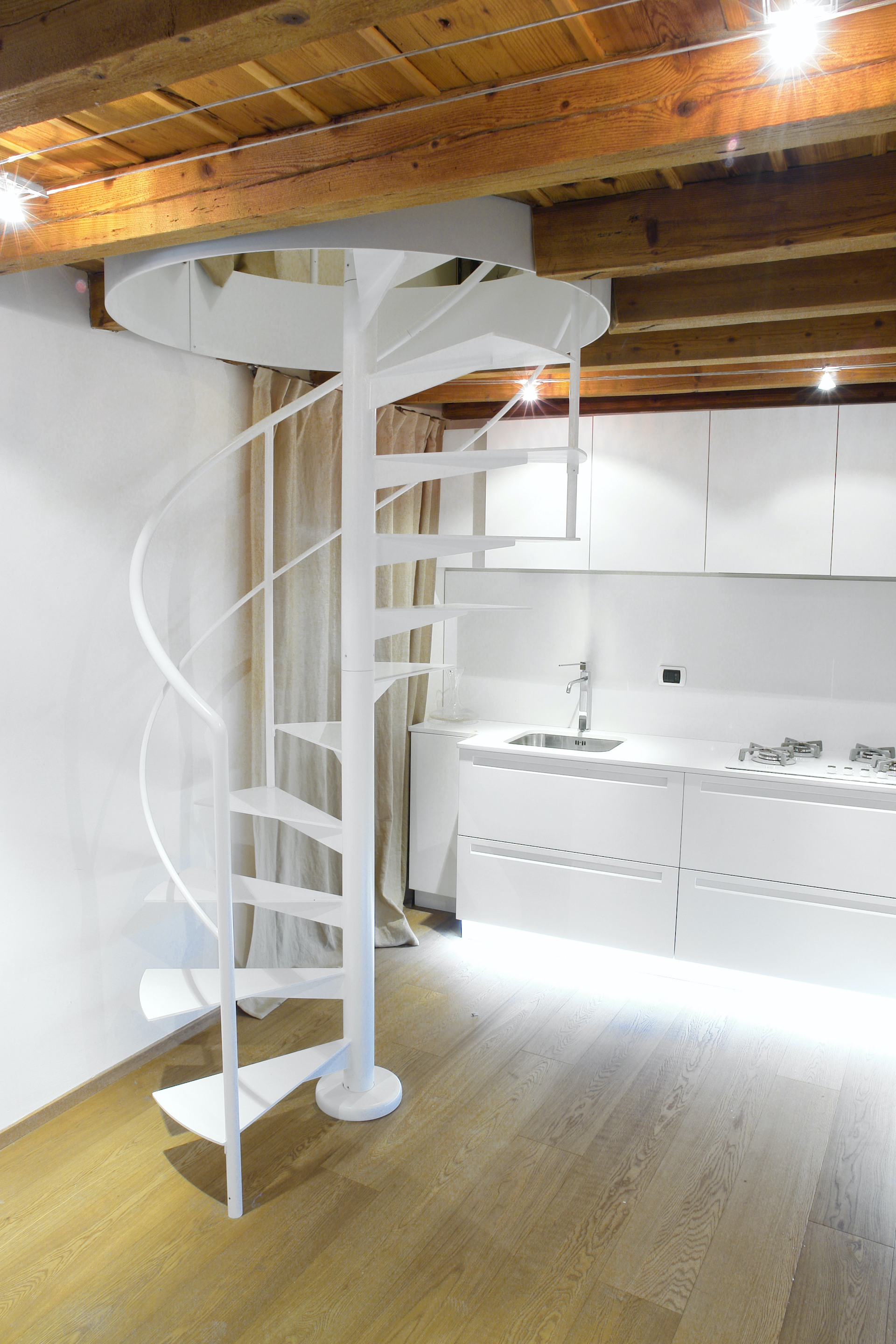
The Vitre staircase corresponds exactly to the classic spiral staircase model, with a central column and spiral shape. Compared to the helical stairs and in particular to the Vortika model that can be enriched and customized in many different variants, Vitre spiral staircase stands out for its essential aesthetics.
Its lines are sinuous and light, the minimal silhouette, with modern elegance it fits in any context. The metal can be left natural but also painted as desired.
Its slender anatomy makes it perfect as a space-saving spiral staircase, excellent in any interior that needs to make the most of spaces with small horizontal footprint but safeguarding comfort and aesthetics.
Modern spiral staircase but also traditional types
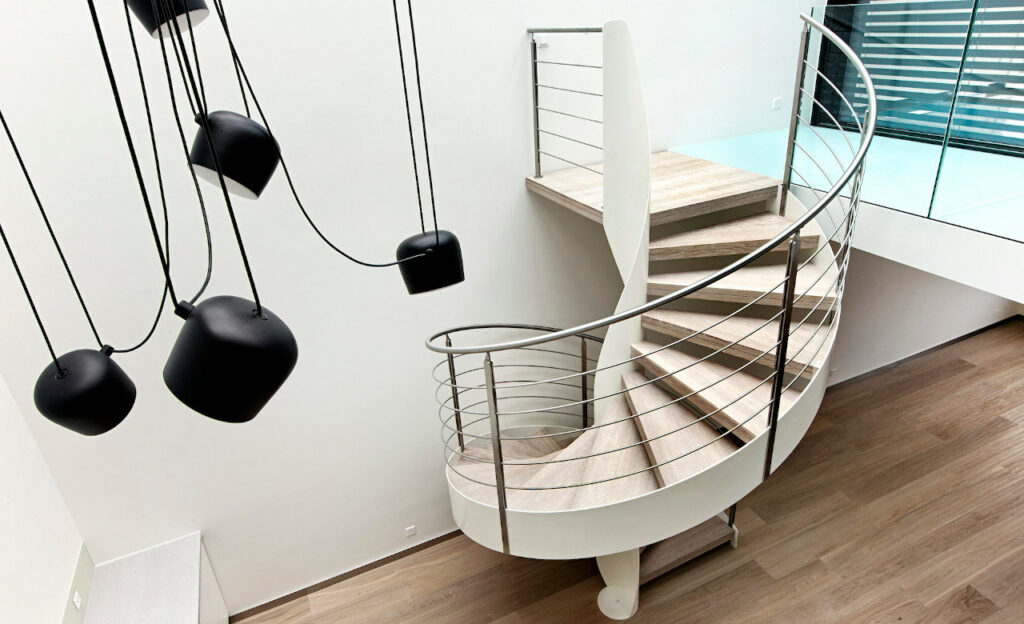
In general we can say that the design trend aims to combine beautiful and useful, and the modern spiral staircase aspires to enhance the environments through the structural shape, materials and through the most appropriate details to your needs.
Without a doubt, it is also possible to install economic spiral staircases (for example a basic loft spiral staircase not too sophisticated), perhaps extremely simple and ready to use with standard sizes, without customizations, functional without excessive aesthetic demands.
It is also true that a customized spiral staircase made, tailored in every little detail and designed to meet your every need for space and design, will probably not be as cheap but will produce a real increase in the prestige of the environment in which you decide to place it.
The market really offers many choices, even up to the semispiral-staircase, a model with a minimal structure to be the real space-saving situation or a small spiral staircase with 70cm diameter… but you can also conceive modern helical stairs imposing and futuristic, or baroque, or comfortable but essential and minimal.
You may love angles but not have enough room for a cantilever staircase, so you might want to opt for a square spiral staircase, or you might want a classic wooden staircase suitable for a not too modern setting.
For example, metal spiral staircase is in vogue, for indoor and outdoor, with different finishes, even oxidized or natural, perfect for contemporary and young industrial environments; or spiral stairs in sweet iron strongly decorated are appreciated..
The modern staircase juggles between tradition, craftsmanship and new technologies.
Like many other objects in our homes, these staircases go beyond its original functional role to become something else, much more, an artifact representative of the style and personality of the host.
Do you want to know more about?
Do you want to know more about the spiral staircase, how to include it in your project or do you have any curiosities to submit to our experts? Fill out the form, and request a free telephone consultation!

